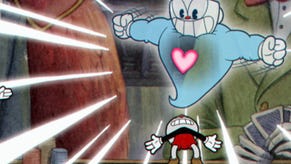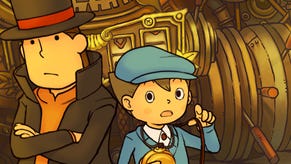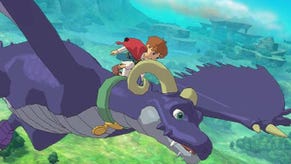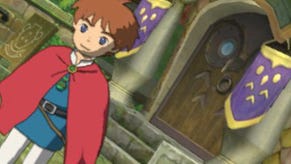Ni No Kuni takes JRPGs back to the familiar
Ni No Kuni: Wrath of the White Witch succeeds in championing a genre all too often derided. John Robertson remembers why JRPGs are the once and future king of single-player gaming.
Ni No Kuni is not only one of the finest JRPGs of this century, it's one of the best games of this century. A wonderful and enthralling example of why this is a genre still worthy of attention and respect.
The Japanese role-playing game is dying in the face of Western efforts. Western RPGs allow more exploration. Western RPGs allow greater diversity of battle tactics. Western RPGs allow you to interact and alter the course of the story. Western RPGs feature online elements that widen and deepen the experience. The Japanese role-playing game is dying.
Or so they say.
For sure, the Japanese videogame industry's continuing identity crisis - coupled with enormously high production costs - has in recent years resulted in genre efforts that are mere shadows of the glorious epics of the nineties. The likes of Tales of Graces and Eternal Sonata aside, there has been little to get excited about in way of JRPGs since the onset of the PlayStation 3 and Xbox 360 era.
What's the saying, though? Class is permanent, form is temporary? We could well have ourselves a case in point.
Hyperbolic statements leave one open to mockery and ridicule at the best of times, but here goes: Ni No Kuni is not only one of the finest JRPGs of this century, it's one of the best games of this century. A wonderful and enthralling example of why this is a genre still worthy of attention and respect.
A collaboration between Professor Layton creators Level 5 and anime producers Studio Ghibli, Ni No Kuni's great trick is not to attempt to rewrite the rules from scratch. Instead, it's the way it skilfully blends various well-known elements into a single experience that makes it such a rich and diverse journey. It's an example of how the whole can be greater than the sum of its parts, familiar components playing off against one another in a way that adds added weight to each action.
Those components that make Ni No Kuni such a delight are the very same ones that have been largely shunned by more popular Western RPGS such as Mass Effect, Skyrim and The Witcher. You'll need to grind through character levels to meet the strength/skill requirements to defeat certain bosses, a Final Fantasy VII-type world map system provides an exact sense of scale to the world and potential exploration and there is no means whatsoever of altering the course of the narrative. Because of this, Ni No Kuni can feel outdated at times. Outdated, but never outplayed or dull.
Each of these elements that have, to some, become dirty design ideas have been implemented with a clarity of purpose that demonstrates how much they still have to give. Take the grind. Usually as attractive and varied as counting Fiats on the motorway, grinding here is given extra life thanks to the 'Familiar' collecting system. Almost a wholesale copy of the core pillar of the Pokemon series, every enemy (excluding bosses) can be caught, added to your squad and used in the game's turn based battles.
Battles are no longer about simply achieving the next level, they're about satisfying every geek's desire to collect for the sake of collecting. Stamps did it, football stickers did it, now Pokemon Familiars have done it.
The way Familiars work in battle also feels nostalgic but fresh. Each of your three squad members is able to take three Familiars with them into battle, although only one is eligible on the field at a time. You're able to swap them in and out as and when you like, a mechanic that is vital to success because of each one's unique abilities and the fact that they all share the same health and magic points. Therefore, it's no good keeping your melee expert active when you're on the verge of death and your healing expert is not going to be much use when you're out of magic points.
Each Familiar really does tend to be very specialised which, combined with the shared health, prevents them from feeling like a rounded fighter in their own right. Your chosen team of three is the single fighter, a fighter that you can meld and forge into something that feels right by getting out in the world and capturing complimentary Familiars.
That level of forced unity is what elevates the system above what's on offer in Pokemon and it's one of the components that keeps you coming back for more; no matter how good your team is, there's always the possibility that it could be better.
Like Tales of Graces, you're only in control of one of your three team members at a time. The other two are controlled by the AI, which does a commendable job of interpreting the situation and acting accordingly. However, you're able to switch between characters and their Familiars whenever you like which prevents you having to deploy the same moves over and again. It's the best of both worlds, you get the clarity of thought that comes with controlling a single character as well as the option of switching it up whenever you like.
The fact that Ni No Kuni is a strictly authored story lets you concentrate on these matters of strategy as a priority, rather than constantly worrying about whether you're selecting the 'right' narrative options for the kind of outcome that you want. Plots that allow you to control the outcome (or, at least, serve up that illusion) are an interesting study in player participation, but there can be no substitute for actually sitting down and being told a story.
Ni No Kuni can feel outdated at times. Outdated, but never outplayed or dull. In the right hands, seemingly archaic genres and mechanics can still work on the big stage.
Like many Japanese RPGs, Ni No Kuni tells a tale that embellishes the same old themes of growing up, friendship, loyalty and self-sacrifice but it's presented in such a way that makes it more charm than cliché. Protagonist Oliver, a thirteen year-old boy on a journey to save his mother, is every bit a character from a Studio Ghibli movie - fiercely ideological and naive, yet brave and smart enough to make it okay for you to like him. Offset that with the crackpot sidekick Mr Drippy and his two other travelling companions (a rogue thief and a feisty teenage girl) and you've got all the elements for a family-friendly story that it's okay for adults to enjoy.
Wrap this up in packaging that features one of the best examples of cel-shaded visuals you've ever seen and Ni No Kuni is a real gem. It’s also proof that, when in the right hands, seemingly archaic genres and mechanics can still work on the big stage.
The mix of different elements means that there's going to be something that draws you in before you get caught up in what else is on offer. For me, the Familiar system and the visuals were the hooks I needed. For you, it might be the sheer scale of the game, the cheerfully sinister narrative or the flexibility of the battle system.
Whatever the case, it's nice to have a JRPG worth getting hot under the collar about again. Class, it seems, really is permanent.
Ni No Kuni: Wrath of the White Witch releases on January 22 in the US and February 1 in Europe, exclusively for PlayStation 3.











